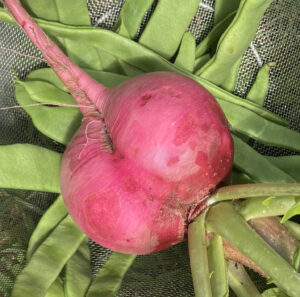 What took me so long? It wasn’t until early this spring that I tasted my first watermelon radish, though I imagine they’ve been around forever. Rough and earthy on the outside, inside they’re a shock of gleaming dark red. Not always solid red, but riffs on the color: rings or spirals or sprinkles of red, swirled against a field of crisp white. It’s no surprise that radishes belong to the mustard family. Though full of nutritional and medicinal benefits, they can be spicy and pungent enough to cause some gastric distress. I’ve discovered, though, that the watermelon variety is milder and less assertive. A Daikon offshoot, it’s also rounder and bigger than most other radishes.
What took me so long? It wasn’t until early this spring that I tasted my first watermelon radish, though I imagine they’ve been around forever. Rough and earthy on the outside, inside they’re a shock of gleaming dark red. Not always solid red, but riffs on the color: rings or spirals or sprinkles of red, swirled against a field of crisp white. It’s no surprise that radishes belong to the mustard family. Though full of nutritional and medicinal benefits, they can be spicy and pungent enough to cause some gastric distress. I’ve discovered, though, that the watermelon variety is milder and less assertive. A Daikon offshoot, it’s also rounder and bigger than most other radishes.
Entranced, I tracked down some watermelon radish seeds and planted them earlier this summer. They sprouted almost overnight and shot up three feet in the air while my back was turned. I finally had to stake them a few weeks ago, right around the time I noticed a thick red bulge pushing up through the earth. Once pulled and washed, the radish turned out to be the size of a small apple. It wasn’t as perfect as the first one I’d tasted – it had a few bumps and dings – but it had the same delicious, almost nutty taste. It would have looked lovely, sliced on top of salad, but it didn’t make it that far.
Radishes
by Ange Mlinko
Smoke and ash of November.
A landscape of sediment and char,
lead and gold leaf, mutilated sod
racing on its planetary camber.
On a kitchen table’s crude altar
a bowl of radishes is offered
with a dish of salt for dipping whole.
That’s how my father would eat them.
My mother sliced them thin.
Theirs was no house in a fairy tale.
Yet the knife that trimmed the stem
and scraped the blemished skin
would halt at her intrepid thumb.
Radishes of rosy cheeks, of snow,
peppery radishes of yesteryear,
which made my tongue go numb,
why are you so much milder now?
You don’t set the mouth on fire.
Did something in your cultivation change,
or does sensation wane with age?
In a French film, I saw two friends
spread butter on radish halves; strange,
I thought, but now it’s all the rage
to sauté them. Their trailing ends
clog my drain-stopper. Best is raw:
it’s “war” backward, like a spell
grown in the cold ground, color
of rose and snow—good to gnaw
a vegetable so filial and feral
late in the year, when the knife is duller.



I like radishes. They are sensual as are many vegetables. I like them sliced thin in a salad too.
Thanks, Cheryl!
Be careful! They naturalize like crazy!! But I share your delight. (And I love them with butter.)
Interesting — I didn’t know that about naturalization. But they certainly grow like crazy. I’ll keep an eye out. Thanks!
We love watermelon radishes! But only the best stores carry them. Thanks for this post!
We need to come up with a good recipe using watermelon radishes!
Love the poem!
Thanks, Susan.
Thank you for tuening my attention to a small thing with so many big things happening in the world. Thanks you Liza for always bringing us back to life’s little wonders. I love the line “they grew…while my back was turned”.
Thanks, Em. They’re not so little now — in fact, they’re taking over the vegetable patch.
I don’t know how you do it, of course there has to be a poem about radishes!
I have never eaten watermelon radishes, so now I will be on the hunt for them.
Beata
You’ll love the deep pink color inside!
Loved this post!!
Thanks, Carole.